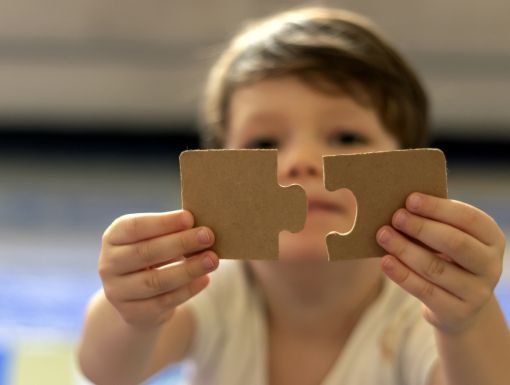
Can Intellectual or Developmental Disabilities Affect a Child's Behavior?
While problem behavior can occur in the general population, children with intellectual and developmental disabilities are at a higher risk of developing mild to severe problem behavior compared to other children. Some estimates show they are 2 to 4 times as likely as the general population to develop severe problem behavior at some point in their lifetime.
Some common problem behaviors observed in children with these types of disorders are aggression (for example, hitting or biting others), self-injurious behavior (for example, hitting or biting oneself), meltdowns (that may include crying, screaming, or falling out for long periods of time), elopement (which includes running or wandering away from caregivers), pica (eating inedible items), or destructive behaviors (such as throwing objects or knocking over furniture). While many of these behaviors are observed as a natural part of child development, they often occur at a higher rate, with more intensity, and for significantly longer periods of time in children with intellectual and developmental disabilities. Children with intellectual or developmental disabilities may not “outgrow” these or other problem behaviors. Specific behavioral interventions to work on reducing these problem behaviors is often needed.
If you have a loved one diagnosed with an intellectual or developmental disability or who is at risk for these or similar diagnoses, having information about why these behaviors tend to start and continue to happen can be helpful in working to prevent them from starting or to prevent them from worsening.
Why do problem behaviors start in the first place?
Often, problem behaviors start when a person does not have a better way to let others know the things they want or need. So, you might see children with limited language skills or language delays use these problem behaviors to communicate likes and dislikes to others.
Problem behavior may lead to some type of “payoff” when it is first noticed. We know that when a behavior “works” it is more likely to happen again. Due to the nature of problem behavior, it is highly likely that someone will notice and may accidentally respond in a way that makes the behavior “work” for the child. This sets the child up to use the problem behavior again in the future when they want or need that same “payoff.”
The child may have limited things they enjoy in general, or they may not have access to things they really like on a consistent basis. When an environment provides little enjoyment, it can set these children up to use problem behaviors to get access to preferred and stimulating things and interactions.
We also know through decades of research that problem behavior is more likely to occur in certain circumstances often referred to as triggers. So, we know that problem behavior is triggered by something specific. Sometimes this trigger is noticeable and sometimes we may not be able to see the specific trigger. Other factors can also set up a trigger to be more or less likely to result in problem behavior. For example, if a child who usually tolerates toothbrushing develops an ulcer on their tongue, they may be more likely to try to avoid toothbrushing because their mouth is hurting. This sets up toothbrushing as a possible trigger for behaviors that will be successful in avoiding toothbrushing, such as pushing the toothbrush away or clenching teeth.
Why do problem behaviors continue to happen?
Problem behaviors sometimes continue to happen due to the way others respond to the behavior when it is first noticed. This is referred to as “socially motivated problem behavior.” The payoff for the problem behavior is something that another person has to give. Problem behavior can also continue to happen due to its own built-in payoff. This is referred to as “automatically reinforced problem behavior.” The payoff for the problem behavior is something that the behavior causes to happen on its own that the child wants to happen again.
There are four common reasons why problem behavior can continue:
- to gain attention from others
- to get toys, things, activities, foods, and more
- to get out of, avoid, or delay something they don’t like
- the behavior itself provides its own, built-in reward (such as relieving pain, feeling good, etc.).
These common “payoffs” are also helpful in showing us what might be common triggers:
- not enough attention, not the right kind of attention
- something being taken away or denied, stopping a favorite activity
- providing an instruction to do something, starting a classwork or homework assignment, the presence of something the child does not like (such as attention from others, crowds, noise, or bright lights)
- having nothing else around to provide stimulation or to occupy their time, internal sensations (such as pain)
Why is this important?
Knowing why problem behavior starts and continues to happen might help us work to prevent it from starting in the first place or to take steps to stop it from getting worse. We can change the child’s environment and remove or add things that can make problem behavior less likely to happen. We can take steps to change the common triggers of problem behavior. We can teach skills deficits that have been linked to higher risks of problem behavior starting (e.g., language skills). We can learn ways to respond (or not respond) to problem behaviors so that they are less likely to continue. We can teach more appropriate ways for the child to get their wants and needs met.
The first step in working to prevent or address these problem behaviors is knowing why they start and continue to happen in the first place.
Learn more about the Michael R. Boh Center for Child Development here.
If you have a child diagnosed with or at risk for intellectual or developmental disabilities and would like more information about applied behavior analysis (ABA) or behavior therapy to prevent or reduce problem behaviors, please contact the Michael R. Boh Center for Child Development.


